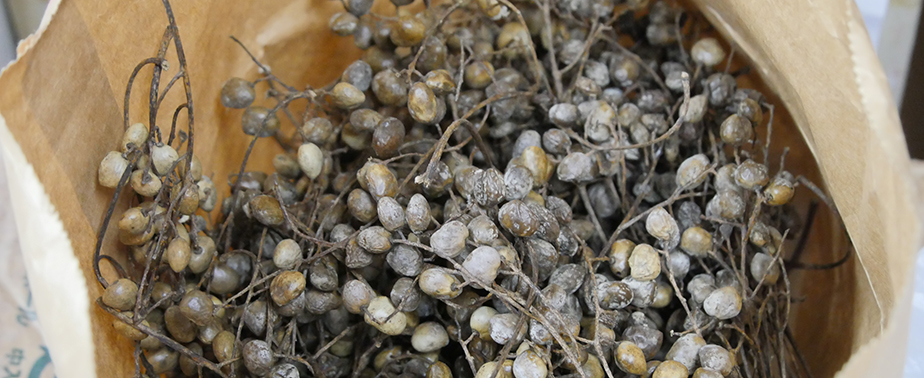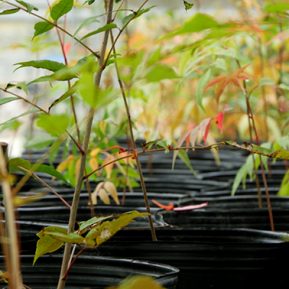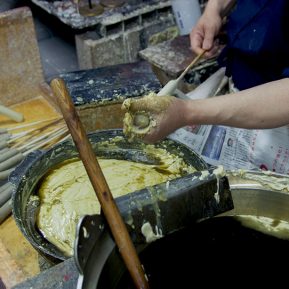
The government’s viewpoint of industrial promotion
Kyoto City has previously tackled the issue of tool and material shortages for traditional industries. It participates as an observer in the Kyoto Traditional Industry Tool Convention, established by the Nishijin Textile Industry Association in 2008, together with the national government and Kyoto Prefecture. Past activities have included acquiring difficult-to-find tools for Nishijin Textiles and creating a database of them. In this initiative, the association borrows these rare tools from operators that have discontinued or closed their businesses and provides them to people that want to use them. This offers great support to young craftsmen starting new businesses in particular, and the association’s activities have made some progress in stabilizing Nishijin’s textile industry.
The Japanese government; Ministry of Economy, Trade and Industry; and Agency for Cultural Affairs implement individual measures, but these are limited to symptomatic treatments focused on factual investigations. And even when support is offered to declining production areas, it is unusual for governments to assist with efforts like this project to create new production areas from scratch.
The following three points were decisive motivators for the government’s support of this project.
- Responsibility was indicated by the incorporated implementing body, named “Japan Wax Kyoto Eternal Co., Ltd.,” established by Nakamura Rousoku Ltd. and other persons involved in traditional industry.
- The possibility of new industry creation in the Keihoku region, which is facing the issues of depopulation and declining forestry and agriculture industries.
- Expectations for growth and sustainability with expected Haze Wax demand not limited to Wa Rosoku.
In other words, in addition to the great cause of saving a traditional industry, sustainable development is also expected for this industry in the Keihoku region. This initiative—started by civilian volunteers striving to ensure stable provision of raw materials for Wa Rosoku—now receives government assistance and involves the public objective of regional revitalization.

A hand cream product created by Nakamura Rousoku that contains Haze Wax. Nakamura Rousoku produces this cream in limited quantities at irregular intervals to inspire new demand for Haze Wax, but the response has greatly exceeded the planned sales volume.
Japan Wax
Few people know that Haze Wax is used as a cosmetic ingredient. “Japan Wax”—the white wax made by further sun drying and purifying Haze Wax—is included in lipsticks, hand creams, and other products by cosmetic manufacturers across the world. Japan Wax was frequently exported until the early Showa Period and was a source of great profit for Haze farmers and wax makers. It is also used in hair oils for traditional hairstyles worn by women and sumo wrestlers and as a separating material for manufacturing foodstuffs such as rice crackers.
The Haze Wax market has been overtaken by petroleum-derived materials. However, it seems likely that demand for high-quality, natural wax can be recovered in light of the recent global trends of clearly specifying cosmetic and food ingredients and using environmentally friendly raw materials.
Nakamura Rousoku started manufacturing and selling a hand cream containing Haze Wax last year. It sold roughly 800 units in just six months and donated 5% (99,000 yen) of the sales to Kyoto City. Kyoto City has decided to use this donation for Haze cultivation. These funds earned with Haze Wax will be returned to Haze Wax production. This is a matter of course in business, but it is not a simple thing in industry-government cooperation, for which budget allotment is quite difficult. This strength serves as a driving force in implementing the project.

Raw materials must be secured to continually uphold the businesses of long-established stores.
Tagawa said, “In addition to cosmetics, Haze Wax has been utilized in printer toner, pencil lead, furniture wax, and other products. Haze Wax is durable and viscous, so it is easy to use in various fields. Of course, this is also the reason for Wa Rosoku’s unique characteristic of not dripping a great deal. The implementing body was incorporated to show our awareness that we are not merely depending on the government. We believe this initiative will only be sustainable if it provides sufficient profit to everyone involved, including the local farmers that grow Haze. All of the members are currently working without pay, but we intend to get the project on track with an eye towards the long term 10 or 20 years from now.”

The Traditional Industries Section (Commerce and Industry Department, Kyoto City Industry and Tourism Bureau) stated, “Wa Rosoku is one of the 74 traditional industries designated by Kyoto City. Our mission is to ensure that this light, passed down by our ancestors, is handed forward to the future. Haze trees are grown in the natural world so we still have a long way to go, but we hope to make steady, repeated efforts to achieve local production for local consumption of Haze in Keihoku in the future.” The budgets for FY2017 onward have yet to be determined, but efforts will be made stressing the importance of sustainability rather than immediate results.
“There is great potential for Haze Wax. By trying to solve the major issue of reviving Haze Wax, we may end up also resolving the Wa Rosoku material problem,” Tagawa said with a laugh.
SPECIAL
TEXT BY YUJI YONEHARA
PHOTOGRAPHS BY SHINGO YAMASAKI
16.12.15 THU 11:18




